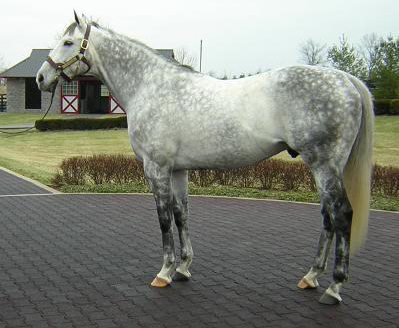 |
| This Welsh Mountain Pony has a lot in common with Diablo... grey: tick! Bulges that may not exactly be muscle: tick! Very enthusiastic trot: tick! Now just imagine that he's four hands taller, with a good dusting of dark freckles through his coat. Pic linked from here. |
Diablo's grey colour was probably inherited from his dam the Welsh Mountain Pony, because this breed has a high proportion of greys (at least it does in the area where I grew up). He would have been born with a darker coat colour like bay, chestnut or black, and greyed with age, with the grey starting to appear with the loss of his foal coat, and white hairs becoming the majority by the time he was two or three years old (although the speed of this greying process does vary between horses and especially between breeds).
In horses, greying with age occurs when your horse inherits a version of the greying gene from a grey parent (it also happens if your horse inherits it from both parents, which can happen if they are both grey).
| Check out the cute grey goggles and nose on this foal! In this picture you can see that as her bay foal coat falls out, the grey coat colour will become visible all over her body. Given that it's probably Mum in the background, Dad must have been the grey one. Pic linked from here. |
- Your horse has two copies of each gene*, one inherited from either parent;
- There are many different versions of each gene in the horse population, some of which can produce identical or nearly identical appearance and biological function, while other versions can produce a different coat colour or cause disease; and
- Each physical characteristic of your horse, including coat colour, results from the combined effects of the two copies of each gene, AND the interactions between a large number of different genes.
The gene that governs greying with age versus not greying with age is called syntaxin-17 (STX17).
 |
| Mmm, pretty dapples. Why DO most people think dappled greys are more attractive than flea-bitten greys? It does seem kind of unfair. Poor Diablo! Pic linked from here. |
Horses that go grey with age have a greatly increased risk of developing melanomas, and can have spotty skin depigmentation too. An outstanding picture of this kind of depigmentation is at The Mare's Tales blog.
 |
| Spotty skin depigmentation can occur along with greying with age. Pic linked through from The Mare's Tales. |
For most people, their grey horse goes completely snow white and only then develops coloured flea-bitten grey flecking. This doesn't necessarily happen all over the body at the same time: for example a horse's head may be flea-bitten, most of its body white, and its legs still faintly dappled. It can also be very hard to tell when the dark flecking of a flea-bitten grey turns up in a horse that greys fast, because they only change coats twice a year, and we only see 6-monthly snap-shots of what's happening to their coat.
If your horse is already almost white, Practical Horse Genetics can carry out genetic testing for the grey gene and the base coat colour genes.
Diablo was mostly flea-bitten when I got him, with some white parts and some darker grey remaining on his legs. His mane and tail were completely white, and I don't recall that there were ever dark hairs in them... which brings me to the final story about him: someone STOLE HIS TAIL! Yes, his thick, snowy tail was cut off just below the tail bone to be a false tail for some loser whose horse didn't have the luscious, snowy locks of my chubby trotting champion! You can no doubt imagine how frustrated and annoyed I was; I can only imagine what Diablo himself thought!
I only hope they bribed him to stand still with so many apples or sugar cubes that he thought it was worth the trade.
PS. I've heard that some people confuse white horses with grey horses, since some grey horses go completely white. From my experience, you could only make this mistake if you'd never seen a real white horse. It's similar to the difference between a blonde and an albino - you might wonder if a very pale blonde person is albino, but when you see someone who really is albino there ain't no wondering about it. Believe me, if you're not thinking 'Wow, a real white horse! That's amazing!', the horse is grey.
* Except for genes on the X and Y chromosomes in male horses, where there may be only one copy.
No comments:
Post a Comment